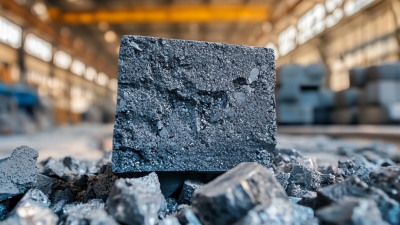Leave Your Message
Silicon Carbide (SiC) has emerged as a pivotal material in modern industries, driven by its unique properties and performance advantages. According to a report by MarketsandMarkets, the silicon carbide market is projected to reach $5.24 billion by 2026, growing at a CAGR of 21.8% from 2021. This rapid growth is attributed to the increasing demand for energy-efficient devices and the rising global emphasis on sustainability.

Industries ranging from automotive to aerospace are leveraging Silicon Carbide for its superior thermal conductivity, high electrical efficiency, and outstanding mechanical strength. As companies strive to innovate and reduce their environmental footprint, SiC serves as a crucial alternative to traditional materials, particularly in high-temperature and high-voltage applications. This blog will explore five essential benefits of Silicon Carbide, highlighting its transformative impact on various sectors and its role in driving technological advancements.
The automotive industry is at the forefront of adopting advanced materials, with silicon carbide (SiC) and gallium nitride (GaN) playing a vital role in enhancing energy efficiency. These semiconductor materials are becoming increasingly important due to their superior thermal conductivity and efficiency compared to traditional silicon-based components. As electric vehicles (EVs) and hybrid technologies continue to rise, SiC and GaN are essential in minimizing energy losses within power electronics, allowing for faster charging and longer battery life.

Moreover, the inherent properties of SiC and GaN enable the production of lighter and more compact power devices. This reduction in size not only improves vehicle performance but also contributes to overall energy savings, as lighter vehicles consume less energy. With automakers actively integrating these materials into their designs, the push for a more sustainable automotive future is gaining traction. As the automotive sector embraces this shift, the synergy between SiC and GaN technologies is set to revolutionize energy efficiency across the industry, paving the way for cleaner and more efficient transportation solutions.
Silicon carbide (SiC) has rapidly emerged as a key player in high-temperature applications, particularly in the automotive and electronics sectors. As industries strive for higher efficiency and performance, SiC's ability to operate at temperatures up to 1400℃ without losing structural integrity makes it indispensable. According to industry reports, the global silicon carbide wafer market is projected to grow from $429.3 million in 2022 to $1.4601 billion by 2029, reflecting a robust compound annual growth rate (CAGR) of 19.1%. This growth is largely driven by the increasing demand for power electronic devices in electric vehicles, where SiC devices play a pivotal role in enhancing energy efficiency.
Tips: When evaluating SiC materials for your projects, consider their thermal conductivity and electrical performance as vital performance indicators. Additionally, staying informed about advancements in SiC technology can help you leverage new opportunities in this fast-evolving market.
The popularity of SiC is also evident in the rising interest in its potential applications aside from automotive, such as in consumer electronics and renewable energy systems. The expected CAGR for SiC semiconductor devices in consumer electronics from 2025 to 2034 is projected to exceed 25.9%, indicating that businesses should prioritize investments in this technology to remain competitive. Embracing SiC innovation can significantly enhance productivity and sustainability across modern industrial applications.
Tips: Engage with industry experts and attend related conferences to gain insights into the latest SiC advancements and applications. Networking in these spaces can uncover collaborative opportunities to boost your business's technological capabilities.
This chart showcases the key advantages of Silicon Carbide in modern industries, emphasizing its exceptional performance in various high-temperature applications. The data visualizes the benefits, highlighting the significant attributes that make Silicon Carbide a preferred material choice in challenging environments.
Silicon carbide (SiC) is revolutionizing the electric vehicle (EV) industry by significantly enhancing vehicle performance and battery life. A recent report by the International Energy Agency (IEA) highlights that SiC's efficiency in heat and power management allows EVs to reach higher power densities. This translates into faster charging times and improved overall energy usage, which is critical as manufacturers strive to meet increasing consumer demand for faster, more efficient vehicles. Studies indicate that implementing SiC components can lead to a 30% increase in energy efficiency compared to traditional silicon-based solutions.
Furthermore, research published in the Journal of Power Sources suggests that SiC semiconductors can withstand higher temperatures and voltages, which contributes to longer lifespan batteries. For instance, vehicles equipped with SiC technology can experience a reduction in thermal losses of up to 50%. This innovation not only extends battery life but also reduces the frequency of replacements, making EVs more cost-effective over time. As the automotive sector moves toward sustainable models, the transition to silicon carbide technologies is proving to be a crucial step in driving the next generation of electric vehicles.
Silicon Carbide (SiC) is revolutionizing power electronics with its unparalleled physical properties, making it a critical material for modern industries. One of its significant advantages is that SiC possesses a bandgap three times wider than that of silicon, allowing for higher efficiency and reliability in power conversion systems. This superior performance translates to enhanced durability in applications such as electric vehicles and renewable energy projects. According to industry reports, the adoption of SiC semiconductor devices is expected to surge as they prove essential for improving the efficiency of converting renewable energy sources like wind and solar power, which is increasingly vital for modern electrical grids.
Furthermore, the global market for silicon carbide is rapidly expanding. The U.S. GAN power device market alone is projected to grow significantly between 2025 and 2033, driven by rising demand for efficient power electronics across automotive, consumer electronics, and telecommunication sectors. As electric vehicles become more mainstream, the need for effective power management systems is paramount. Analysts predict that the automotive onboard power inverter market will exceed $578.8 million by 2023, with a projected compound annual growth rate of 5.4% through 2032, further highlighting the indispensable role that silicon carbide plays in enhancing the reliability and efficiency of power electronics in this transformative landscape.
| Benefit | Description | Impact on Power Electronics |
|---|---|---|
| High Thermal Conductivity | Silicon Carbide provides superior heat dissipation compared to silicon. | Reduces the risk of overheating in power devices, enhancing reliability. |
| Wide Bandgap | Allows operation at higher voltages and temperatures. | Increases efficiency and size reduction of power converters. |
| High Breakdown Voltage | Can withstand very high electric fields without breaking down. | Enhances reliability in high-voltage applications. |
| Low Switching Losses | Minimizes energy loss during switching operations. | Improves overall system efficiency and reliability. |
| Chemical Stability | Resistant to oxidation and thermal degradation. | Ensures longevity and durability in harsh environments. |
 Silicon carbide (SiC) is rapidly emerging as a cornerstone material in renewable energy technologies. Its remarkable properties, such as high thermal conductivity, wide bandgap, and superior efficiency, make it ideal for applications in solar inverters, electric vehicles, and energy storage systems. As industries strive for greener alternatives, SiC stands out by significantly reducing energy losses, thereby enhancing the overall performance and sustainability of renewable energy solutions.
Silicon carbide (SiC) is rapidly emerging as a cornerstone material in renewable energy technologies. Its remarkable properties, such as high thermal conductivity, wide bandgap, and superior efficiency, make it ideal for applications in solar inverters, electric vehicles, and energy storage systems. As industries strive for greener alternatives, SiC stands out by significantly reducing energy losses, thereby enhancing the overall performance and sustainability of renewable energy solutions.
When integrating silicon carbide into renewable energy systems, consider optimizing thermal management. Efficient heat dissipation is crucial to leveraging SiC's full potential, so investing in advanced cooling technologies can improve reliability and lifespan. Furthermore, adopting SiC-based converters can lead to smaller, lighter designs, offering immense benefits in space-constrained applications.
Another tip for leveraging SiC in renewable technologies is to stay updated with the latest research and innovations. As the field evolves, new fabrication techniques and device configurations could enhance performance even further. Collaborating with suppliers who specialize in SiC materials and components can also unlock new opportunities to innovate and optimize energy systems for a sustainable future.






